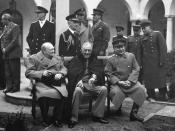After World War II ended, the tensions between the United States and the Soviet Union escalated over their different ideas in carrying out the plans from the Yalta Conference. The U.S. and the Soviets were trying to rebuild the countries that Germany had either conquered or destroyed. In setting up the governments of these countries, (such as Poland) the Yalta conference had stated that no Nazi or Fascist powers could be in place. However, the Soviets and the United States defined Fascism very differently. The Soviet Union saw Fascist as those that didn't fight the Germans back, while the U.S. felt they were the people that didn't help Germany. This difference was the reason why the Soviets claimed they were placing Communist leaders in the countries they were helping rebuild. The Iran Crisis of 1946 was another factor that created tension between the U.S. and the Soviet Union. The Iran Crisis had occurred because the Soviets weren't leaving as Azerbaijan as they had agreed to do.
Finally the Soviet Union agreed to leave if Iran would agree to a join oil company. After the Soviet Union left, the Iranian Parliament voted no to the oil company agreement and the Shah asked the U.S. to help. The threat of U.S. involvement kept the Soviets out of Iran but escalated the tension.
As the "Iron Curtain" began to descend, the United States struggled to find strategies to fight the Cold War that was setting in with the Soviet Union.
One of the key players in helping America deal with the Soviets and the Cold War was George F. Kennan. After Stalin's ominous speech in February 1946, Kennan drafted the "Long Telegram" which sounded the alarm over Soviet expansionism and became a warning about the Cold War. His telegram made his reputation...


